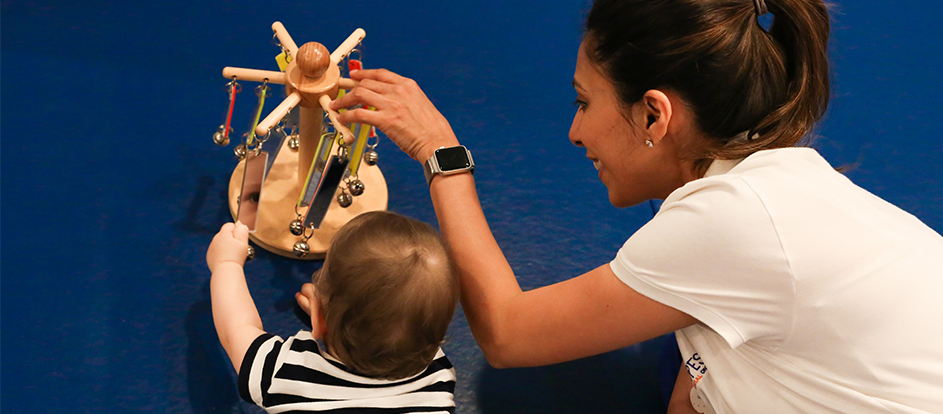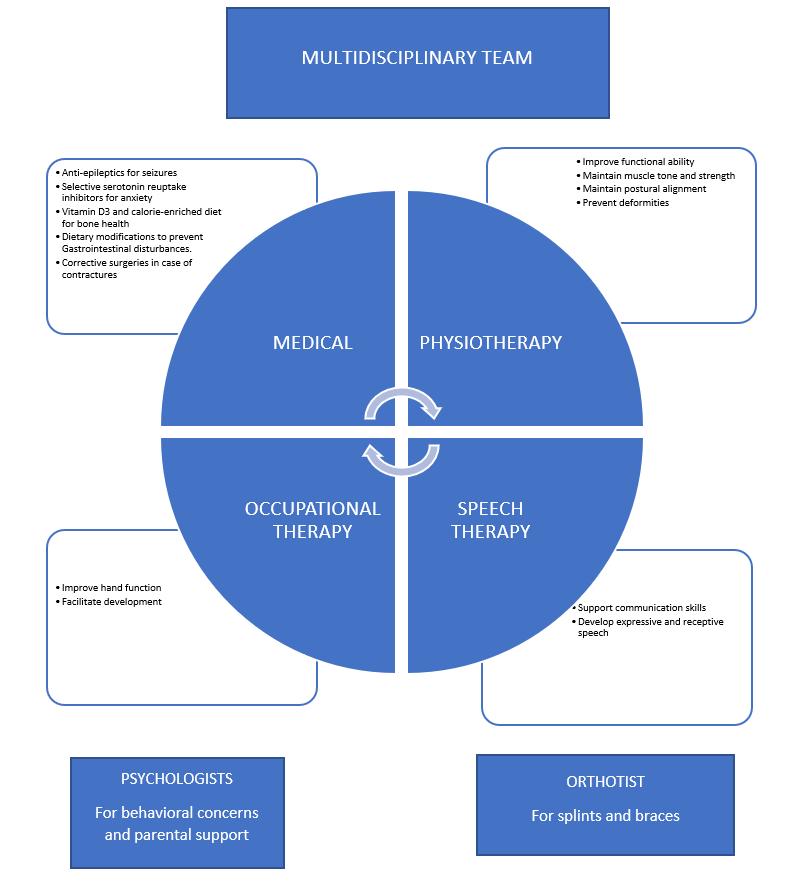

Recognizing and Managing Rett Syndrome

Sujata Noronha
Senior Pediatric Physical Therapist
DHA License Number: 21863269-001

Rett syndrome is a rare, progressive neurodevelopment condition that mostly affects females and is characterized by physical and cognitive developmental impairment (Gold et al, 2018). Rett syndrome is caused by the mutation of the MECP2 gene on the X chromosome.
Incidence and diagnosis
Rett syndrome is a non-hereditary genetic condition that occurs in 1 in 10,000-15,000 female births, and it is even rarer in males.
Children with Rett syndrome develop as expected for the first 6 to 18 months and then progressively exhibit physical and cognitive regression, such as the loss of hand use, low muscle tone, and walking and speech difficulties.
Rett syndrome is diagnosed following genetic testing and clinical examinations.
Recognizing Rett syndrome
Major symptoms include:
- Loss of acquired gross and fine motor skills, such as head control, crawling, walking, and purposeful use of hand
- Loss of acquired speech
- Repetitive hand movements: wringing or clapping hands
- Loss of mobility specifically gait abilities in ambulant children
Other symptoms include:
- Breathing irregularities
- Sleep disturbances
- Gastrointestinal issues, including reflux and constipation
- Teeth grinding, gnashing, or clenching (bruxism)
- Behavioral issues
- Cognitive impairment
- Scoliosis
- Decreased bone density.
Stages of Rett syndrome

Managing Rett syndrome
Life expectancy of a person with Rett syndrome depends on the age of diagnosis and symptom severity. Many people with the syndrome live a long life, with almost all girls affected reaching the age of 10 and more than half of them reaching the age 50 (Kirby et al, 2010).
Although there is no cure for Rett syndrome yet, current treatment focuses on managing symptoms to enhance quality of life, function, and communication skills.
A multidisciplinary tailored therapeutic approach that considers the needs of the child and the family is required to help the child reach their maximal potential, and an early start is essential. A person with Rett syndrome requires therapeutic interventions for life (Lotan, 2006).
The importance of movement for people with Rett syndrome
Physiotherapy and movement is integral to maintaining the mobility and functions of a person with Rett syndrome (Hanks, 1986), as it focuses on the following ten areas:
- Facilitating development milestones (e.g.: crawling, standing, walking)
The pediatric physiotherapist aims to help the child such motor development milestones as crawling, standing, walking by promoting:
-
- Postural control
- Muscle strength and endurance
- Reciprocal movements
- Balance and coordination.
- Maintaining joint integrity: Children with Rett syndrome tend to walk with an ataxic gait and have improper weight bearing on the foot, leading to malalignment and foot deformity. The aim of physiotherapy is to:
-
- Maintain foot alignment
- Stretching and strengthening
- Gait training
- Use of appropriate orthotics, like ankle foot orthosis to maintain the joints and prevent deformity.
- Promoting bone strength and mineralization: Children with Rett syndrome have decreased bone density and more vulnerable to fracture. The bone density is promoted by:
- Encouraging regular standing and walking
- Using standers or walkers if needed
- Postural care: Scoliosis is the most common comorbidity in Rett syndrome (Logan, 2014), which can cause pain, loss of sitting control, and progressive restrictive lung disease. The physiotherapist will work on:
- Proper positioning in lying, sitting, and standing, and maintenance of posture
- Regularly check the spinal alignment
- Recommend spinal brace
- Breathing patterns and maintaining lung capacity.
- Maintain movement repertoire:
- Encourage repetitive functional movements and motor planning to reduce apraxia.
- Gait training: Rett syndrome affects a person’s walking pattern and balance. The physiotherapist will work on retraining gait using:
- Postural control
- Single limb balance
- Anticipatory reactions
- Obstacle paths.
- Hand function: Physiotherapy will encourage hand use for functional activities through:
- Active weight-bearing exercises for hand
- Incorporating hand functions in exercises and splinting as required.
- Use of adaptive equipment: Maintaining the child’s independence and mobility is integral for their functional and social participation. The physiotherapist might recommend the use of walking aids or wheelchair, depending on the child’s needs.
- Parent training: Parents play a very important role as caregivers in a child with Rett syndrome. The physiotherapist can provide guidance on:
-
- Appropriate positioning at home in lying and sitting
- Carrying techniques
- How to encourage correct walking patterns.
- Hydrotherapy: A qualified intervention therapist will engage with the child in water-based activities to stimulate:
-
- Relaxation
- Correct breathing pattern
- Head control
- Effective use of hands
- Balance and walking.
A tailored and multidisciplinary treatment plan is the most effective approach to managing Rett syndrome, to ensure the best quality of life, prevent deformities and encourage/facilitate further development. In addition to conventional therapies such as physiotherapy, occupational therapy, speech therapy, alternative therapies like music therapy and hippotherapy can benefit people with Rett syndrome.
We at High Hopes know how unique each child is, and our multidisciplinary team works with the child and their parents to create an individualized treatment plan that helps enhance functional and social participation. Contact us today to learn more about our services.
Sources:
1) Rett Syndrome: A Genetic Update and Clinical Review Focusing on Comorbidities (Gold et al) https://doi.org/10.1021/acschemneuro.7b00346
3) Evidence-Based Physical Therapy for Individuals with Rett Syndrome: A Systematic Review (Fonzo et al) https://www.ncbi.nlm.nih.gov/pmc/articles/PMC7407501/
4) Rett Syndrome. A Review with Emphasis on Clinical Characteristics and Intervention (Lotan) https://doi.org/10.1100/tsw.2006.249
5) Clinical Guidelines for Management of Bone Health in Rett Syndrome Based on Expert Consensus and Available Evidence (Jefferson et al) https://doi.org/10.1371/journal.pone.0146824




